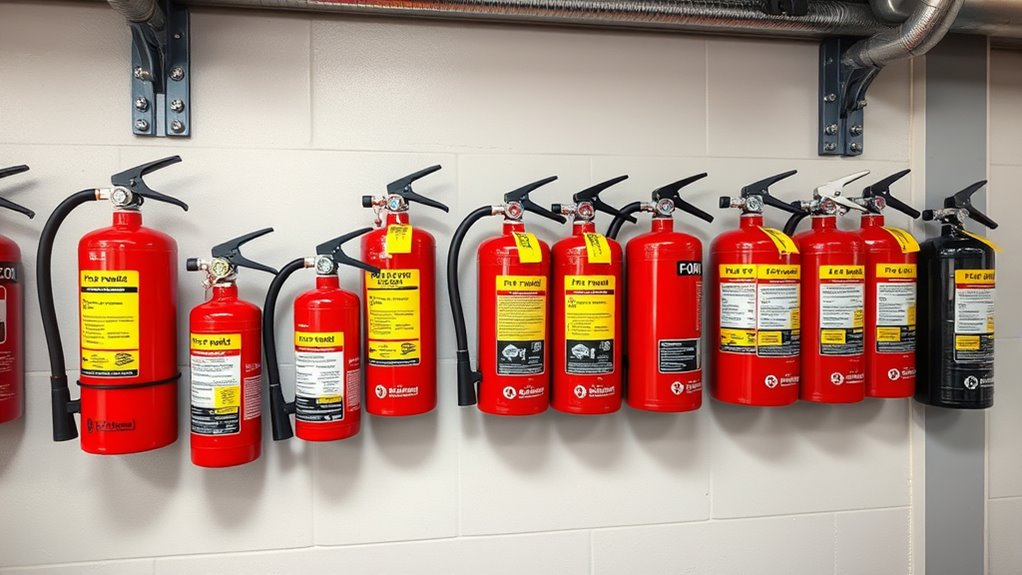Knowing your fire extinguisher types is key to safety; Class A works on everyday fires like paper or wood, while Class B handles flammable liquids, and Class C is for electrical fires. Multi-purpose ABC extinguishers combine these capabilities. Regular monthly checks are essential—inspect pressure gauges, physical condition, seals, nozzles, and expiration dates. Proper storage and maintenance ensure quick, effective responses when emergencies happen. Continue exploring to discover detailed steps for keeping your fire safety equipment in top shape.
Key Takeaways
- Differentiate fire extinguisher types (A, B, C, ABC) to ensure proper use during emergencies.
- Conduct monthly visual inspections to check pressure gauge, physical condition, pin, and nozzle for damage or obstructions.
- Verify that manufacturing and expiration dates are valid to ensure extinguisher effectiveness and safety.
- Ensure extinguishers are accessible, properly mounted, and stored in visible, unobstructed locations.
- Maintain records of inspections and schedule professional servicing for ongoing safety and compliance.

Have you ever wondered which fire extinguisher is best for different types of fires? Choosing the right fire extinguisher depends on understanding the various fire extinguisher types available and knowing how to perform proper maintenance procedures. Each type is designed to combat specific kinds of fires, so selecting the correct one is vital for safety and effectiveness. For instance, Class A extinguishers are suitable for ordinary combustibles like wood, paper, and cloth, while Class B extinguishers work best on flammable liquids such as gasoline or oil. Class C extinguishers are meant for electrical fires, and multi-purpose ABC extinguishers combine these capabilities for versatile use.
Understanding the different fire extinguisher types helps you respond correctly to a fire emergency. But knowing which to use isn’t enough; you also need to regularly perform maintenance procedures to make certain they work when needed. Maintenance procedures involve more than just checking the pressure gauge; you should also inspect the physical condition of the extinguisher, ensuring it’s free from damage, corrosion, or leakage. Confirm that the safety pin and seal are intact, and verify the nozzle or hose is unobstructed. A simple visual inspection monthly can catch issues early, preventing the extinguisher from failing during an emergency.
Regularly inspect fire extinguishers for damage, corrosion, and leaks to ensure they function properly during emergencies.
When performing these maintenance procedures, don’t forget to check the manufacturing and expiration dates. Extinguishers don’t last forever, and most require recharge or replacement after use or when they reach their expiration date. If you notice any damage, corrosion, or if the pressure gauge isn’t in the green zone, it’s time to service or replace the unit. Keep a record of your inspections to track when each extinguisher was last checked, and schedule professional maintenance periodically, especially for larger or more complex systems. Regular maintenance also involves understanding the role of Projector Contrast Ratios, which can be essential for optimal visibility in presentation environments.
Additionally, make certain your fire extinguishers are easily accessible and mounted in visible, unobstructed locations. Proper placement makes a significant difference in emergency situations, allowing you to grab and use the right extinguisher quickly. Remember, a well-maintained extinguisher that’s correctly stored can be the difference between containing a fire and facing a dangerous escalation. Regularly practicing fire safety measures, including monthly checks, boosts your preparedness and confidence. By understanding fire extinguisher types and diligently following maintenance procedures, you’re taking essential steps toward safeguarding your environment and everyone in it.
Frequently Asked Questions
How Often Should Fire Extinguishers Be Replaced?
You should replace fire extinguishers when they reach their expiration date or fail the maintenance schedule. Check the replacement criteria regularly, typically every 5 to 15 years depending on the type. If you notice corrosion, damage, or a pressure loss, substitute them immediately. Proper maintenance ensures they function effectively in emergencies. Keep track of inspection dates and follow manufacturer guidelines to ensure your fire safety equipment remains reliable.
Are There Fire Extinguishers Suitable for Electronic Fires?
Sure, there are fire extinguishers designed specifically for electronic fires—no, your standard ABC extinguisher won’t cut it. For electrical fire suppression, you need specialized extinguisher types like CO2 or Class C extinguishers. These are crafted to handle sensitive electronics without causing damage. So, next time you face a spark in your server room, don’t grab the wrong extinguisher—trust the right tools for the job, or risk turning a spark into a disaster.
Can I Use a General-Purpose Extinguisher on All Fire Types?
You can’t rely on a single extinguisher for all fire types, as multipurpose compatibility is limited. While some extinguishers offer good versatility, they’re designed primarily for specific fires like Class ABC. Using the wrong extinguisher can be ineffective or dangerous. It’s best to have the right type nearby. Always check the label for extinguisher versatility and verify it matches the fire you might encounter to stay safe.
What Are the Signs of a Damaged Fire Extinguisher?
If your fire extinguisher shows signs of trouble, it’s like a warning bell ringing. You’ll notice visual damage such as dents, corrosion, or leaks, and pressure loss that indicates it may not work properly when needed. Don’t ignore these signs—examine it regularly. If anything looks off, replace or service it immediately. A damaged extinguisher is like a silent alarm—useless in an emergency.
Do Fire Extinguishers Expire or Lose Effectiveness Over Time?
Fire extinguishers do expire and can lose effectiveness over time. Regular fire extinguisher maintenance guarantees they stay functional, so check the pressure gauge and inspect for damage. Proper storage best practices involve keeping them in accessible, cool, and dry locations, away from heat or chemicals. By following these guidelines, you ensure your extinguisher remains reliable during emergencies, preventing potential hazards caused by expired or ineffective units.
Conclusion
Knowing the different fire extinguisher types and performing monthly checks can truly save lives and property. It’s a simple habit that guarantees your fire safety equipment works when you need it most. Some believe that regular checks are unnecessary, but evidence shows they markedly boost effectiveness and safety. Stay proactive, stay prepared, and trust that a little effort today can prevent disaster tomorrow. Your vigilance makes all the difference in protecting yourself and those around you.









